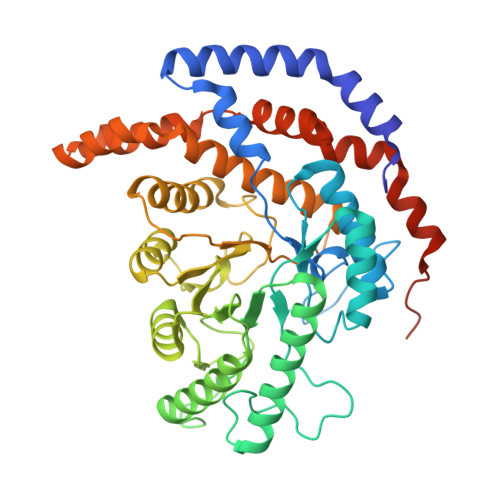Elucidation of the role of Ser329 and the C-terminal region in the catalytic activity of Pseudomonas stutzeri L-rhamnose isomerase
Yoshida, H., Takeda, K., Izumori, K., Kamitori, S.(2010) Protein Eng Des Sel 23: 919-927
- PubMed: 20977999
- DOI: https://doi.org/10.1093/protein/gzq077
- Primary Citation of Related Structures:
3M0H, 3M0L, 3M0M, 3M0V, 3M0X, 3M0Y - PubMed Abstract:
Pseudomonas stutzeri l-rhamnose isomerase (l-RhI) is capable of catalyzing the isomerization between various aldoses and ketoses, showing high catalytic activity with broad substrate-specificity compared with Escherichia coli l-RhI. In a previous study, the crystal structure of P. stutzeri l-RhI revealed an active site comparable with that of E. coli l-RhI and d-xylose isomerases (d-XIs) with structurally conserved amino acids, but also with a different residue seemingly responsible for the specificity of P. stutzeri l-RhI, though the residue itself does not interact with the bound substrate. This residue, Ser329, corresponds to Phe336 in E. coli l-RhI and Lys294 in Actinoplanes missouriensis d-XI. To elucidate the role of Ser329 in P. stutzeri l-RhI, we constructed mutants, S329F (E. coli l-RhI type), S329K (A. missouriensis d-XI type), S329L and S329A. Analyses of the catalytic activity and crystal structure of the mutants revealed a hydroxyl group of Ser329 to be crucial for catalytic activity via interaction with a water molecule. In addition, in complexes with substrate, the mutants S329F and S329L exhibited significant electron density in the C-terminal region not observed in the wild-type P. stutzeri l-RhI. The C-terminal region of P. stutzeri l-RhI has flexibility and shows a flip-flop movement at the inter-molecular surface of the dimeric form.
Organizational Affiliation:
Division of Structural Biology, Life Science Research Center and Faculty of Medicine, Kagawa University, 1750-1 Ikenobe, Miki-cho, Kita-gun, Kagawa 761-0793, Japan.
















